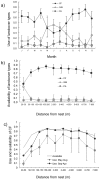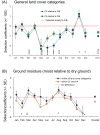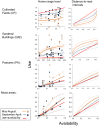Weather conditions drive dynamic habitat selection in a generalist predator
- PMID: 24516615
- PMCID: PMC3916403
- DOI: 10.1371/journal.pone.0088221
Weather conditions drive dynamic habitat selection in a generalist predator
Abstract
Despite the dynamic nature of habitat selection, temporal variation as arising from factors such as weather are rarely quantified in species-habitat relationships. We analysed habitat use and selection (use/availability) of foraging, radio-tagged little owls (Athene noctua), a nocturnal, year-round resident generalist predator, to see how this varied as a function of weather, season and availability. Use of the two most frequently used land cover types, gardens/buildings and cultivated fields varied more than 3-fold as a simple function of season and weather through linear effects of wind and quadratic effects of temperature. Even when controlling for the temporal context, both land cover types were used more evenly than predicted from variation in availability (functional response in habitat selection). Use of two other land cover categories (pastures and moist areas) increased linearly with temperature and was proportional to their availability. The study shows that habitat selection by generalist foragers may be highly dependent on temporal variables such as weather, probably because such foragers switch between weather dependent feeding opportunities offered by different land cover types. An opportunistic foraging strategy in a landscape with erratically appearing feeding opportunities in different land cover types, may possibly also explain decreasing selection of the two most frequently used land cover types with increasing availability.
Conflict of interest statement
Figures






Similar articles
-
Fine-scale movement patterns and habitat selection of little owls (Athene noctua) from two declining populations.PLoS One. 2021 Sep 27;16(9):e0256608. doi: 10.1371/journal.pone.0256608. eCollection 2021. PLoS One. 2021. PMID: 34570774 Free PMC article.
-
Temporal scales, trade-offs, and functional responses in red deer habitat selection.Ecology. 2009 Mar;90(3):699-710. doi: 10.1890/08-0576.1. Ecology. 2009. PMID: 19341140
-
'Bodyguard' plants: predator-escape performance influences microhabitat choice by nightjars.Behav Processes. 2014 Mar;103:145-9. doi: 10.1016/j.beproc.2013.11.007. Epub 2013 Nov 25. Behav Processes. 2014. PMID: 24286818
-
Seasonal variation in preference dictates space use in an invasive generalist.PLoS One. 2018 Jul 20;13(7):e0199078. doi: 10.1371/journal.pone.0199078. eCollection 2018. PLoS One. 2018. PMID: 30028855 Free PMC article.
-
Isolating weather effects from seasonal activity patterns of a temperate North American Colubrid.Oecologia. 2015 Aug;178(4):1251-9. doi: 10.1007/s00442-015-3300-z. Epub 2015 Apr 5. Oecologia. 2015. PMID: 25842295
Cited by
-
Impact of land cover and landfills on the breeding effect and nest occupancy of the white stork in Poland.Sci Rep. 2021 Mar 31;11(1):7279. doi: 10.1038/s41598-021-86529-z. Sci Rep. 2021. PMID: 33790344 Free PMC article.
-
Juvenile survival of little owls decreases with snow cover.Ecol Evol. 2024 May 20;14(5):e11379. doi: 10.1002/ece3.11379. eCollection 2024 May. Ecol Evol. 2024. PMID: 38770120 Free PMC article.
-
Fine-scale movement patterns and habitat selection of little owls (Athene noctua) from two declining populations.PLoS One. 2021 Sep 27;16(9):e0256608. doi: 10.1371/journal.pone.0256608. eCollection 2021. PLoS One. 2021. PMID: 34570774 Free PMC article.
-
Coping with drought? The hidden microhabitat selection and underground movements of amphisbaenians under summer drought conditions.Curr Zool. 2023 Aug 16;70(5):647-658. doi: 10.1093/cz/zoad034. eCollection 2024 Oct. Curr Zool. 2023. PMID: 39463696 Free PMC article.
-
Using population viability analysis, genomics, and habitat suitability to forecast future population patterns of Little Owl Athene noctua across Europe.Ecol Evol. 2017 Nov 12;7(24):10987-11001. doi: 10.1002/ece3.3629. eCollection 2017 Dec. Ecol Evol. 2017. PMID: 29299275 Free PMC article.
References
-
- McLoughlin PD, Morris DW, Fortin D, Vander Wal E, Contasti AL (2010) Considering ecological dynamics in resource selection functions. Journal of Animal Ecology 79: 4–12. - PubMed
-
- Johnson DH (1980) The Comparison of Usage and Availability Measurements for Evaluating Resource Preference. Ecology 61: 65–71.
-
- Aebischer NJ, Robertson PA, Kenward RE (1993) Compositional Analysis of Habitat Use from Animal Radio-Tracking Data. Ecology 74: 1313–1325.
Publication types
MeSH terms
LinkOut - more resources
Full Text Sources
Other Literature Sources

